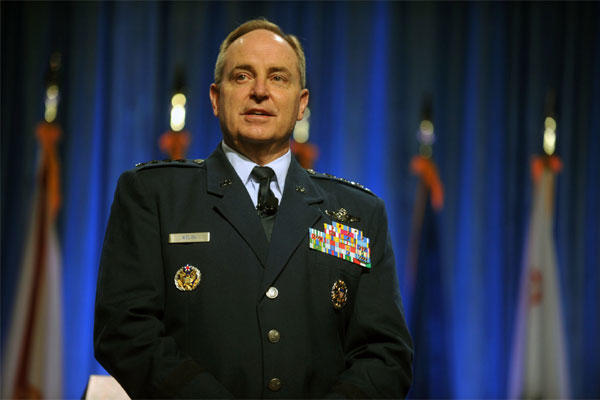GRAND FORKS AIR FORCE BASE, N.D. – The Air Force must control the growth of pay and benefits or the service will be hard pressed to perform its primary mission to fight and win America’s wars, the service’s top officer said here Nov. 25.
Air Force Chief of Staff Gen. Mark A. Welsh III said pay, benefits and medical costs constitute about half of the Air Force’s budget -- and those costs are growing.
Left unchecked there will come a time when the service cannot do its job “because all we’re doing is paying our people,” Welsh said. Some experts believe this will occur in 2023, others by 2032.
All service leaders agree there’s a problem, he said.
The general said this is not a scare tactic on the part of senior leaders in DoD.
“There is absolutely no motivation for a service chief to try and scare people in his service -- none,” Welsh said. “Everything we do is about taking care of them. Nobody cares more about the men and women in our services than the service chiefs. And nobody wants to do what’s right for them more than we do. Scaring them is the last thing on our minds.”
Welsh said no service leader is talking about cutting pay and benefits, just slowing the growth. He speaks of managing growth in a different way.
“Our people will understand that,” the general said.
The U.S. Congress, the Department of Defense and the services have over the past 20 years provided excellent benefits and comparable pay to military members.
“We’ve all benefited immensely and we thank them for that,” Welsh said. “But it is time to slow it down a little bit until we know we can do our primary job, which is fight and win the nation’s wars.”
He wants Congress to consider things like slowing down the growth of the military pay raise for the next couple of years while DoD grapples with fiscal issues caused by sequestration.
The service chiefs understand and accept that the department must do its part to deal with America’s national debt.
“But no one would argue the mechanism of sequestration is the most effective way to do that. It’s absolutely not,” Welsh said.
The way sequestration operates is the problem, he said.
“Every business in the world -- if it wanted to downsize and refocus -- would take down infrastructure the first couple of years, reinvest the savings in the product lines that work and then make the cuts over the second half of the 10-year period,” Welsh said.
This is not the way sequestration operates. DoD cannot touch infrastructure and personnel accounts are protected. The money has to come from somewhere and that means funds for modernization and readiness will be hit most heavily.
“We haven’t been allowed to slow growth on the pay side or the medical side or do anything about infrastructure costs, so everything is going to come out of modernization, force structure and readiness,” Welsh said. “There is no other option. That’s where the money is.”


























